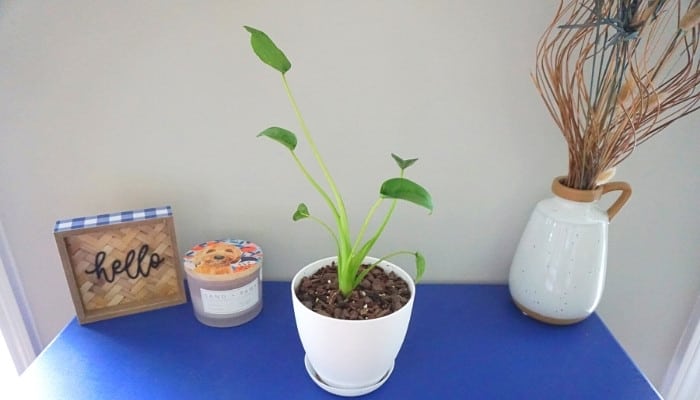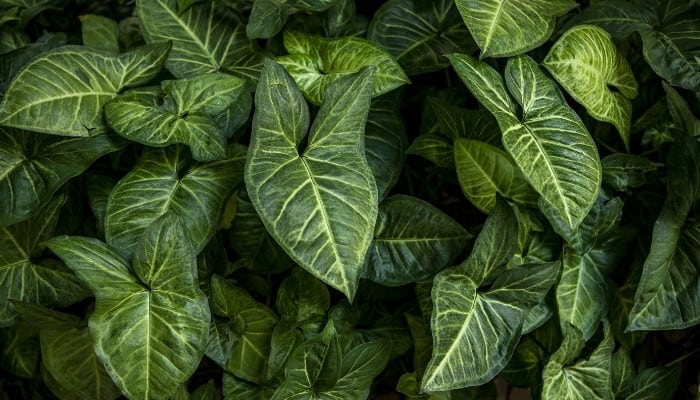Alocasia plants are truly remarkable, with a variety of shapes and sizes that many of us may not be familiar with.
These tropical-looking plants capture the attention of anyone who sees them, making them great natural centerpieces in your home.
Are Alocasia plants easy to grow? Alocasia are semi-demanding plants that grow well in indirect light with temperatures of 60°F to 80°F and 60-70% humidity. Water once per week during the warm months and once every few weeks during the winter. During active growth, fertilize once per month. They are not hard to grow.
Read on below and learn everything you need to know to start properly caring for your Alocasia plants!
Easy Care Guide for Alocasia
Alocasia is a lovely and eyebrow-raising houseplant.
One of the best parts about them is that regardless of how rare and exotic they look, Alocasia plants aren’t hard to grow at all once you understand them.
In the following sections, we break down each aspect of caring for Alocasia in greater detail.
How To Pot Alocasia
The first step to bringing an Alocasia into your home is potting it.
Before potting it in just any old pot, find one with good drainage holes. The best size pot for Alocasia, generally speaking, is 24 to 36 inches.
Use a light, slightly acidic potting soil with perlite mixed in.
Water the Alocasia 45 minutes to an hour before you plan on potting it.
Fill the pot a third of the way up with potting soil, and then place the Alocasia’s roots, spread out, into the pot.
Fill the remaining two-thirds or so of the pot with your growing medium. Water the plant immediately, and you’re finished.
If your soil doesn’t drain well, you’re going to have major issues like bacteria and root rot. Make sure to use a quick-draining soil and a pot with drainage holes.
Best Growing Conditions for Alocasia
Alocasia isn’t exactly as hard to grow as they’re made out to be by all those elite gardeners.
That said, without the right information, they can indeed be trickier than other houseplants to care for.
In nature, Alocasia grows on the forest floors under a thick canopy. That means indirect but bright sunlight is the best natural light for this plant.
As far as temperatures go, if you keep the temperatures of your home between 65°F and 80°F, Alocasia will do just fine.
Keep your plants somewhere above 60°F, and you’ll keep them happy.
The tricky part about growing Alocasia is in the humidity; they prefer 60 to 70% humidity.
Anything less than 60% humidity is not enough to create conditions in which your Alocasia will thrive.
As most homes are not nearly that humid, the use of a humidifier is recommended.
This ultra-quiet model with a 2.2 liter tank is ideal as you can aim the cool mist directly toward your plant with the rotating nozzle.
Watering Alocasia
On average, Alocasia needs water once every week or so. Alocasia is a plant that enjoys a constant presence of moisture but not being overly saturated.
The best practice for watering Alocasia is to water it only once two-thirds of the soil is dry.
If you’re not using a moisture meter, just stick your fingers an inch or two into the soil. If your fingers are dry, the plant is dry too.
If not, you may want to wait to water until later to water your Alocasia.
For winter waterings, you can slow down to watering once every 3-5 weeks depending on the soil and environment in which you’re keeping it.
Alocasia Fertilization Guidelines
As with many hardy house plants, Alocasia requires only light fertilizing.
You may fertilize your Alocasia with an all-purpose type of houseplant fertilizer once every month or so. I recommend going with an organic option for your plant’s health.
If your soil is in poor shape, fertilizing a week or two early won’t hurt.
If your soil is too moist, the plants won’t absorb enough nutrients regardless of how well fertilized you’re keeping it.
If fertilizing outdoors Alocasia, you may opt for a powder form of fertilizer that mixes into water. In that case, approximately 1 pound of fertilizer covers 50 square feet.
Repotting Alocasia
The main point to remember about repotting Alocasia is that you need to hydrate it well before moving and transplanting it.
Also, give extra care and attention to the roots, and spread them open before covering them with fresh growing medium.
Give a careful inspection to the entire root system of the plant before repotting. Remove any brown, yellow, or slime-covered roots.
Otherwise, your newly potted plant may contract root rot or harmful bacteria.
Best Alocasia Varieties To Grow

With nearly 100 species to currently choose from, picking from the best Alocasia varieties to grow can be challenging.
A few of the most popular Alocasia species to grow at home include:
- Alocasia cucullata
- A. lauterbachiana
- A. rugosa or A. melo
- A. sanderiana
- A. ‘Triangularis’
- A. ‘Wentii’
- A. ‘Black Velvet’
- A. ‘Dragon Scale’
- A. macrorrhizos ‘Elephant Ear’
- Frydek Alocasia
- A. ‘Ivory Coast’
- A. macrorrhizos ‘Tiger Taro’
- A. macrorrhizos ‘Stingray’
- Pink Dragon Alocasia
- Alocasia ‘Polly’
- A. cuprea ‘Red Secret’
- Silver Dragon Alocasia
- A. zebrina
- Alocasia ‘Tiny Dancer’
The above list is made up of Alocasia species most used by home gardeners. There are currently 97 recognized species of Alocasia on the books.
Alocasia Propagation
Propagating Alocasia couldn’t be easier if you wanted it to be. All you need to do is wait until spring or early summer, and dig them up.
Once the plant is dug up, you can pick the newly formed bulbous parts or split the central rhizome, and replant them as multiple plants.
Remember to allow enough space in between your currently existing Alocasias and the bulbs you plant.
Also, make sure to water them thoroughly for the next two to three weeks (on a daily basis).
Once the new plants appear through the soil, reduce watering to every few days. Eventually, as the plants grow taller and stronger, you may reduce the watering again.
This time cut the watering down to every 5 to 10 days depending on the plant and location.
Related Questions:
How Do You Prune Alocasia?
Alocasia is a super simple plant to prune. In reality, it doesn’t require nearly as much pruning as other plants.
To prune it, simply bend and pull it away (if it is rotten) or cut away unwanted stems all the way down to the base of the plant.
There is no need to prune Alocasia other than to remove dead or dying growth. Pruning Alocasia does not speed up or encourage new growth.
How Do You Know If an Alocasia Has Root Rot?
If your Alocasia has been looking under the weather for a few days (or weeks) and you’re beginning to suspect root rot, pull the plant from the pot, and inspect its underside.
If the roots are gray, yellow, brown, or have black spots and are slimy and smelly, there is no doubt that they have root rot.
Otherwise, perhaps the plant is underwatered, overwatered, or not receiving the right amount of light.
Growing Alocasia
Alocasia is a beautiful and exotic houseplant that comes in many shapes, sizes, and varieties.
From ‘Silver Satin’ to ‘Dragon Scale’, there’s surely an Alocasia variety that fits the personality of you and your home.
If you’re new to caring for Alocasia, please feel free to bookmark this guide and refer back as often as needed!

